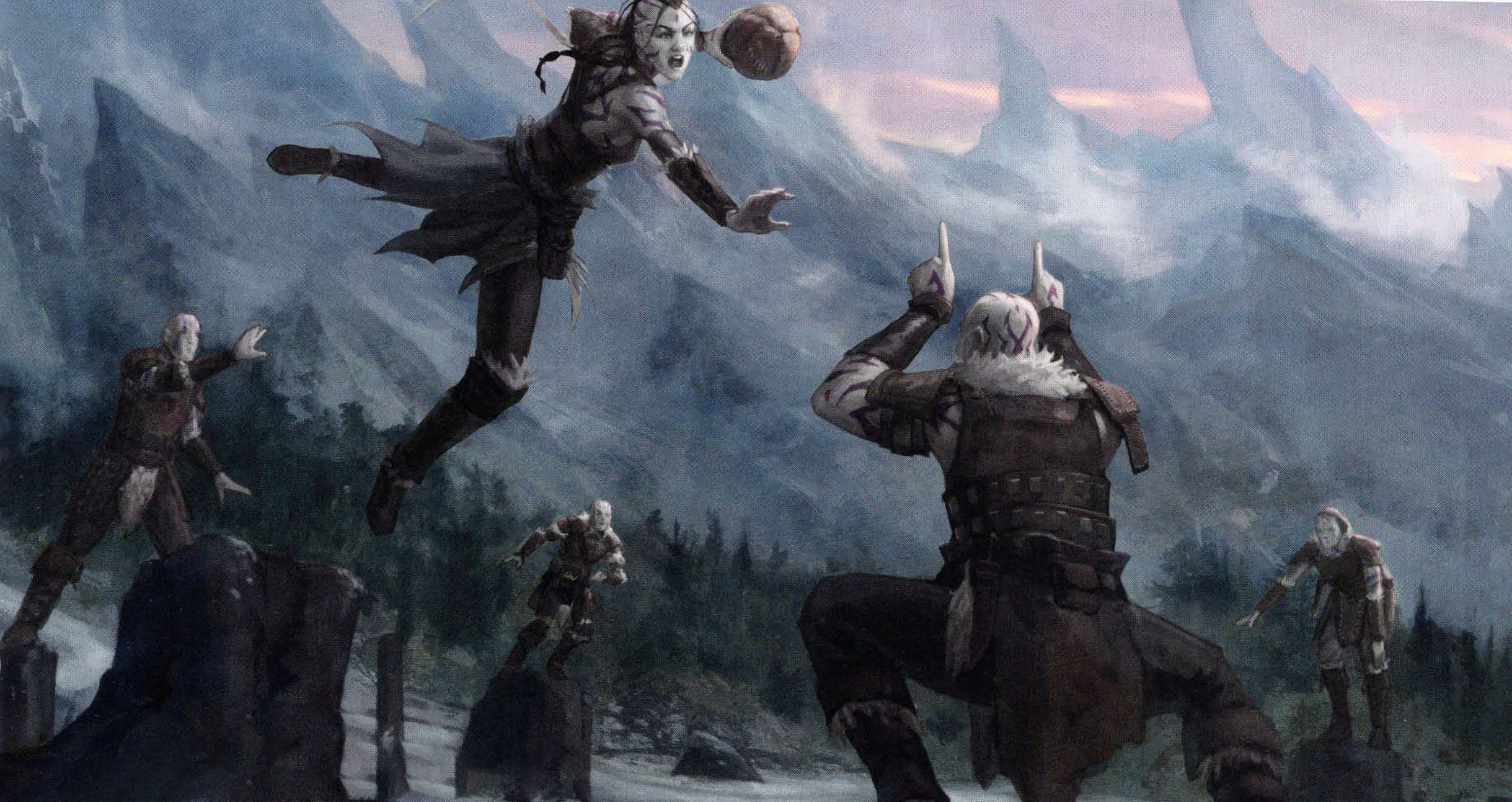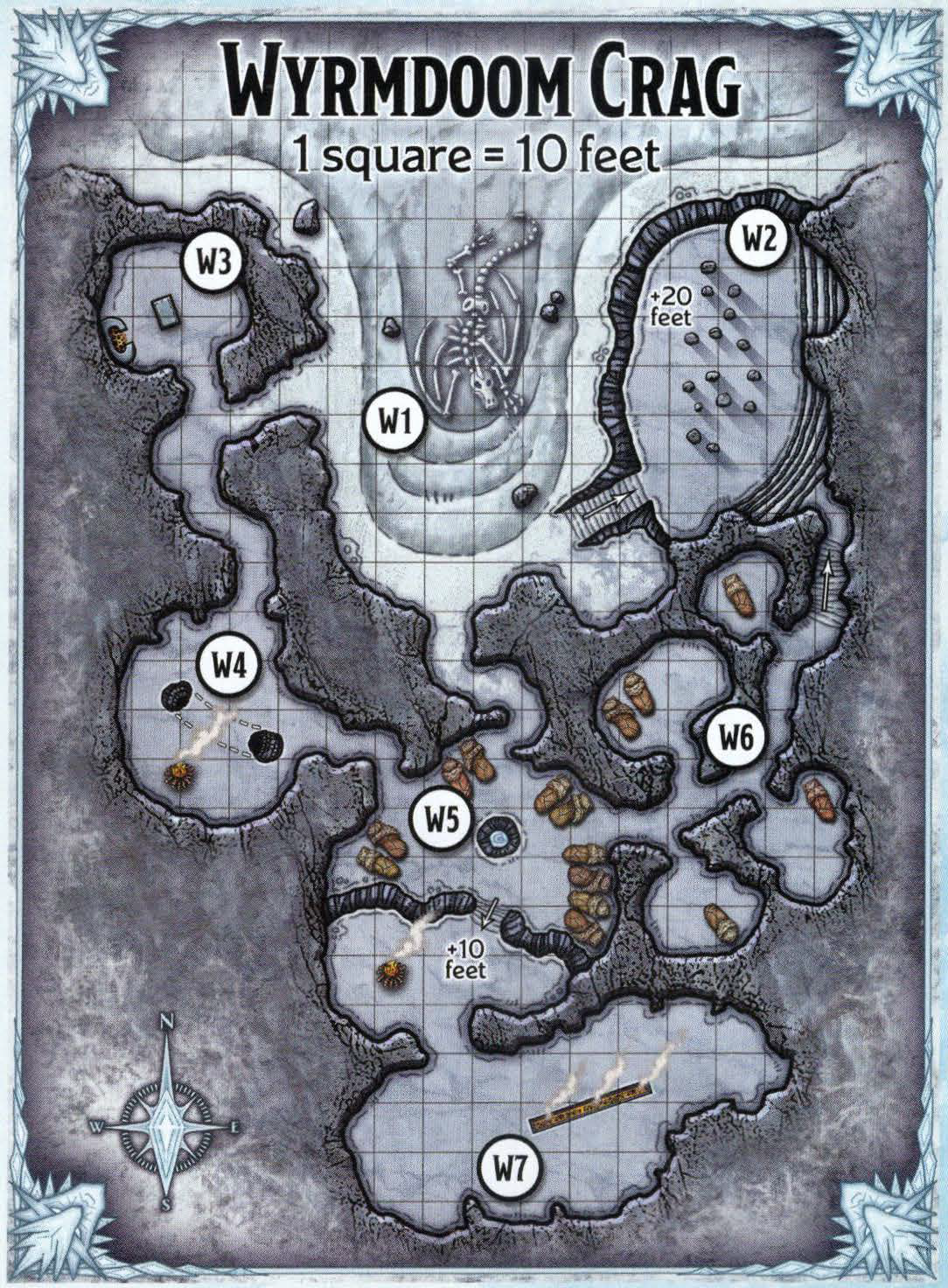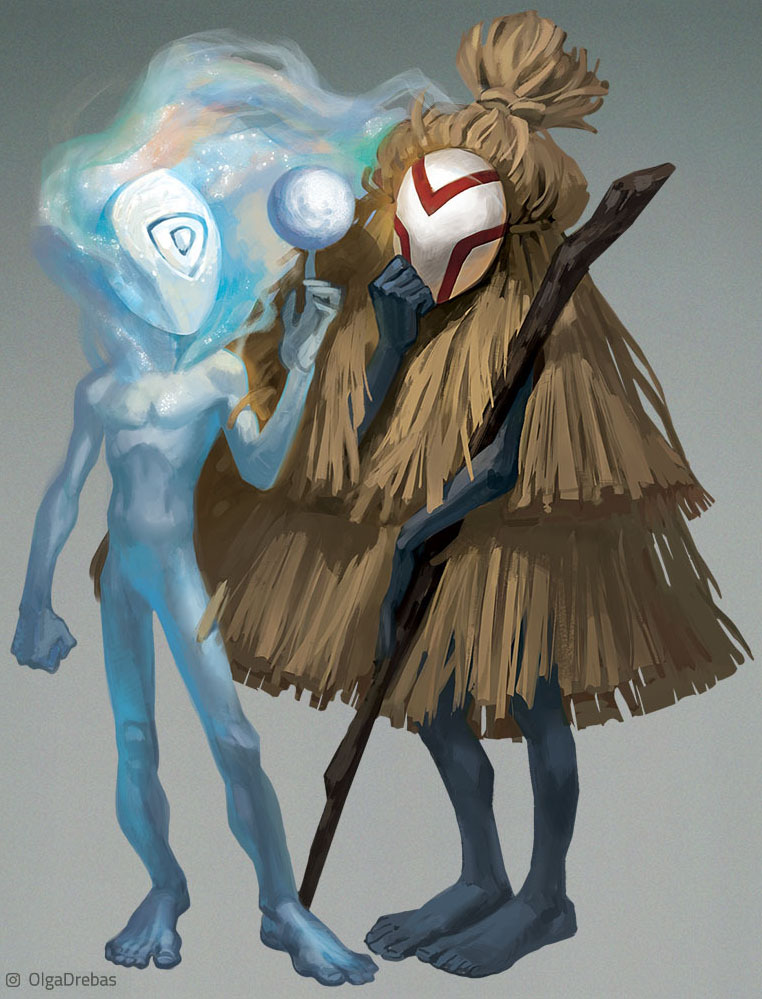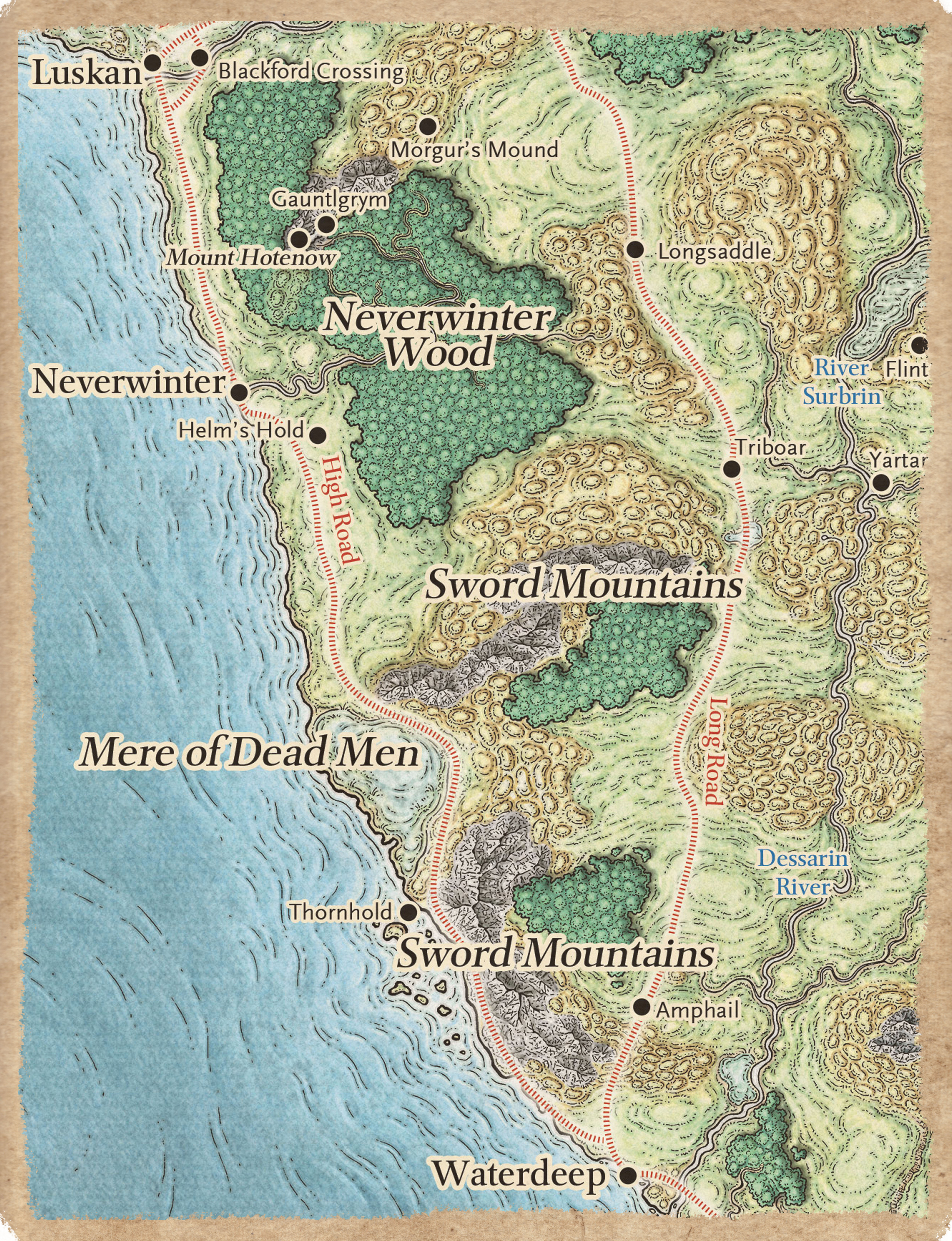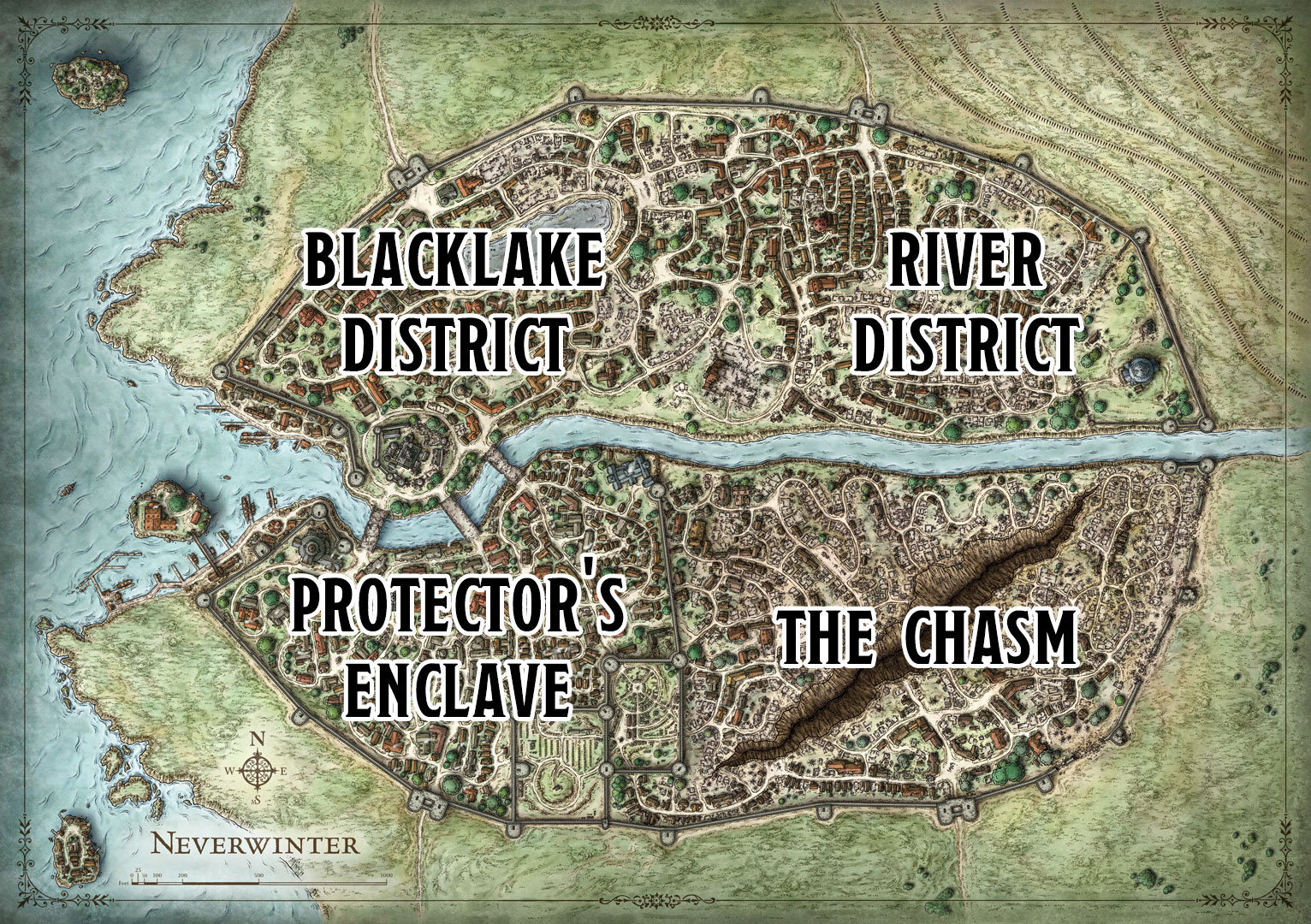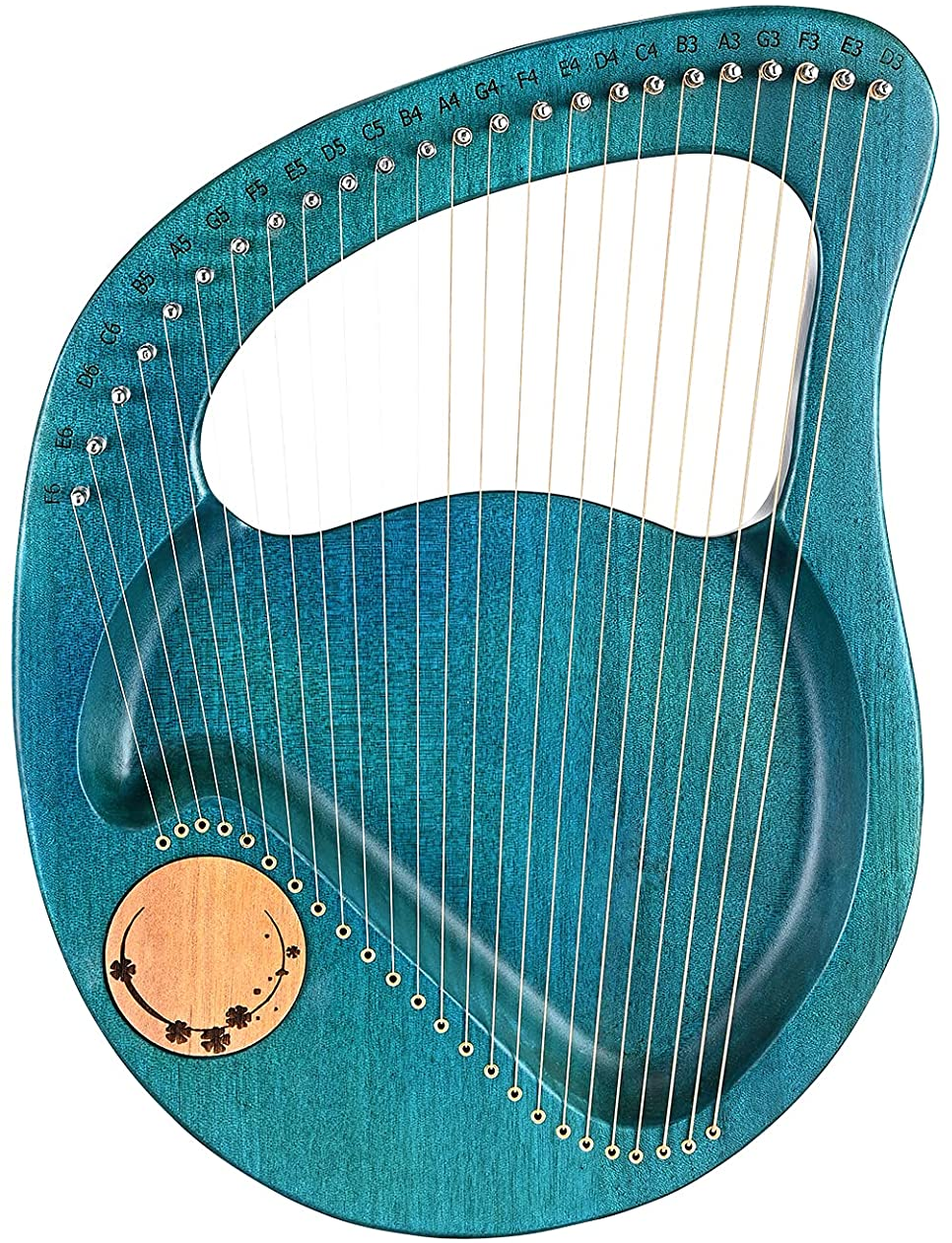
Go to Part 1
YGRA DUNN
(Created by Heather Burmeister)
Ygra (pronounced EE-grah) Dunn was born to human parents someplace in Ten-Towns. Or so she assumes. She has no idea where she was born or who her parents are, but she does know that somewhere in the wilderness north of Ten-Towns, she was… lost? Abandoned? The Frozenfar can be treacherous and it’s not unheard of for travelers with children to lose them in one of the hellish snowstorms that sweep the territory during winter.
Regardless of how she ended up there, one thing she does know is that she’s the luckiest human on this side of the Spine of the World. For reasons still unknown to her, she was spared from icy doom and was taken in by a yeti clan. The yetis raised Ygra as one of their own, and she formed deep bonds with her new family unit, especially the yeti Uziwe. Uziwe taught Ygra all about the landscape and how to move in it, and made her a part of the family unit. It was also common among the yeti to learn how to defend themselves against the weapons the humans used. Ygra learned their fighting style, their customs and their language, and was protected throughout her childhood. Coming of age proved difficult, however, with her differences from the tribe becoming more pronounced, and there were many things Uziwe could not teach her. Ygra set off on her own when she was a teen to find her place again among humans.
It started with following the caravans, getting close to them. Ygra inherited a natural distrust of people from her yeti mother figure, and also didn’t speak Common. She discovered quickly which humans were apt to part with some meager rations and which ones would chase her away with weapons. She also quickly learned that if a caravan had stopped to camp at night you didn’t always have to beg for the food, you could just take it. Through her training with the yetis, Ygra knew how to use the landscape to her advantage and hide from any guards that were posted. She was very successful, making off with rations that were delicious – salted meats, dried fruits, things she’d never tasted. She also sometimes came away with furs and pelts she would craft into clothing which she desperately needed. The only time she failed was in trying to steal anything from Reddick Lightbrewer, and that failure changed her life forever.
Reddick was a dwarven caravan guard who caught Ygra rifling through his belongings while she thought he was asleep. Naturally, the dwarf attacked, but he was alarmed to discover a gangly, gaunt-looking teen. Regardless, Ygra almost bested him with nothing but her fists and fled into the surrounding area. Reddick, fascinated by this seemingly primitive youth, continued to come into the wilderness where he’d last seen the girl and leave rations, clothing, and warm blankets. He’d camp nearby, and each time the supplies were gone. Through his kindness, she began to trust him, and eventually accompanied him to the city of Bryn Shander. Reddick lived in a small shack on the outskirts of town, and more or less adopted her as his strange ward. She helped with cooking, cleaning, mending and housework and he’d teach her Common, Dwarvish, and how to read and write. Most importantly, though, he taught her how to fight with weapons. That was her favorite part. Ygra spent countless hours sparring with Reddick, learning the atlatl and quarterstaff.
She got good enough that, when she came of age, Reddick invited her to come along with him on the caravans between Ten-Towns as a guide and guard. Her Common and Dwarvish got even better, and she learned some exciting new words that Reddick deemed “weren’t for ladies,” but she said them anyway.
Ygra was an excellent guide. She’d disappear on the trails ahead only to circle back around behind the caravan like a ghost to confirm that coast was clear. Life was good and went on like this for a number of years until the day when Reddick disappeared. There was a note left one morning, hastily written in Dwarvish, and all it said was, “Watch yourself. Take care of yourself. Back soon”.
The days passed and morphed slowly into weeks, which bled into months, and then, eventually, time just spread out into a new normalcy. Ygra told anyone looking for Reddick as a guide that he’d be returning, but she could help. She still kept the cabin clean, his quarters especially, and settled into a pattern of waiting. Ten years passed like this.
Eventually the upkeep and waiting for a ghost wore on her. She grew tired of keeping up a place that wasn’t hers in the hope that something might change. So, just as she’d done when she’d barely become a teen, she struck out on her own. The fishing captains in Targos were looking for guards to keep their catches safe from thieves on the docks and from sea monsters on the lakes, and the money was good. She left a note for Reddick on the table, locked the front door, and struck out.
Ygra has lived in Targos for the past four years, working for a variety of captains, occasionally freelancing for the Dockworkers’ Guild, and intermittently going back to the old work of guiding and guarding caravans. Lately, Skath, the captain of the local militia since Speaker Naerth was elected a little while back, has been eagerly pursuing her; encouraging her to sign up for the militia, although she’s turned him down several times. She’s known around the city and has a few acquaintances, maybe even friends. She has a humble home on the outskirts of town which stays warm and comfortable, even now that the cold has somehow gotten… colder.
But when the caravans bring her close, she still stops by the shack in Bryn Shander to check for signs of Reddick, and keeps her ear to the ground listening for clues.
DESCRIPTION
Ygra is a small human woman, barely 5′ tall. She has deep, coal colored eyes and dark auburn hair, almost black. Her skin is tanned and weathered from her years spent in the elements, and sometimes she still speaks with a strange cadence, or has an odd turn of phrase in common. Her clothes are largely homemade from different animal furs or skins, but recently she almost exclusively wears her fur tundra gear to protect from the cold. When asked, she says she was raised outside of Bryn Shander, closely guarding her yeti upbringing.
YETI CLANS
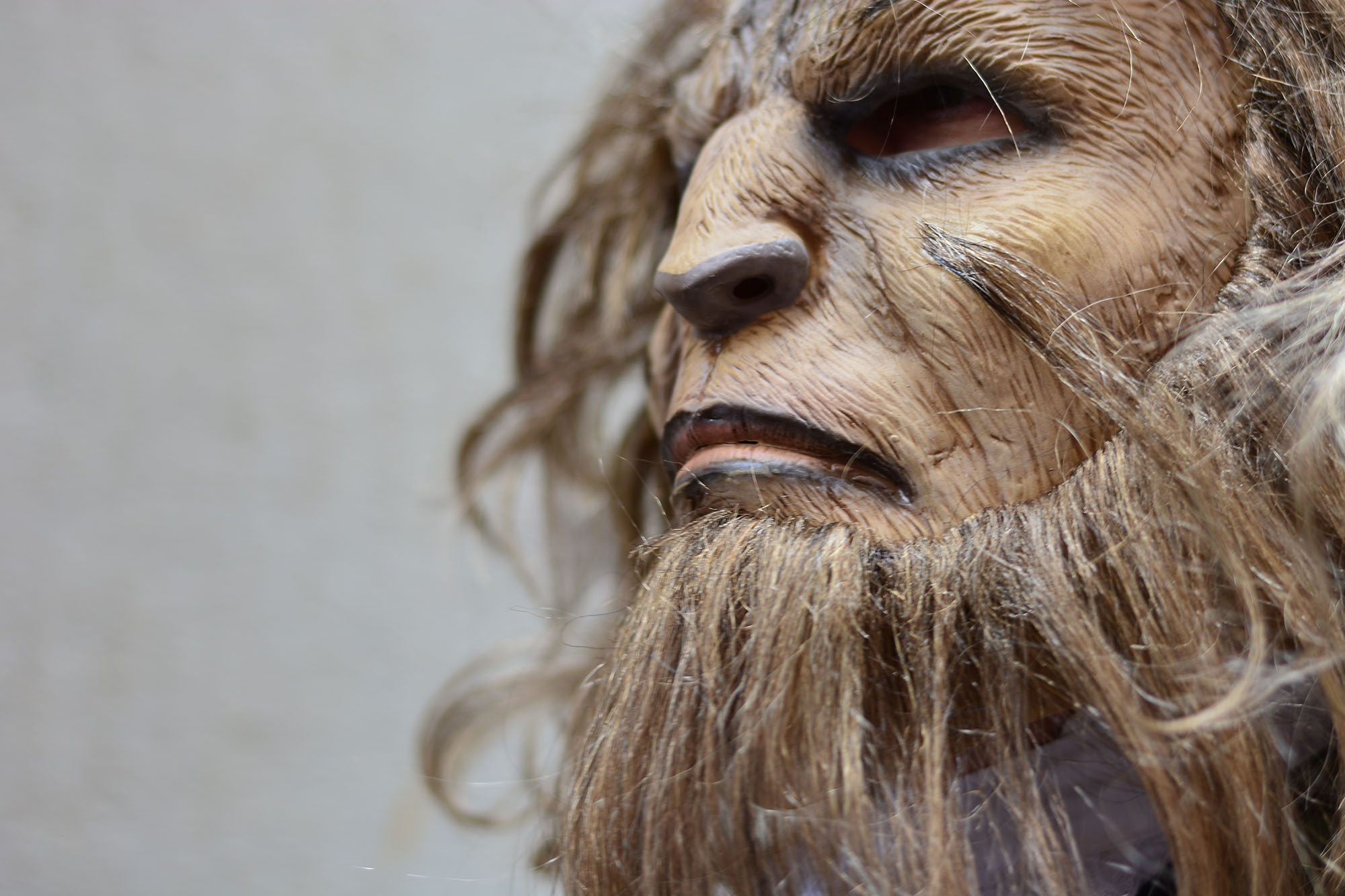
Yeti clans in the area around Ten-Towns are divided between the glacial clans (like the one Ygra belonged to) and the mountain prides (who live up in the Spine of the World).
The glacial clans are matriarchal. Or, more accurately, almost entirely feminine. Mothers and daughters create huddles and establish homes (often in glacial caves). Male yetis among the glacial clans are solitary and nomadic, being cast out from the clan homes at a very young age and visiting them only rarely in later years.
The mountain prides are small bands of mixed gender strongly organized around the leadership of whichever yeti has proven themselves strongest. The prides are more fractious and far less stable than the glacial tribes, with yeti frequently shifting between prides and prides frequently splitting apart or subjugating rivals.
The clans and prides are only loosely organized into large societies, lacking both the size and order of the Reghed clans (see below). But they are very distinct from each other, with slightly different dialects of the Yeti tongue and usually proffering violence when they encounter each other.
REGHED TRIBES
The Reghed often hunted and clashed with the yeti, and the glacial clans in particular have a long-running feud with them. Ygra was taught to fear the Reghed, for they were not to be trusted, and she heard many tales of how they had murdered, hunted, or plundered the homes of the yeti. She never saw their murderous violence firsthand, but on more than one occasion a hunting party of yeti would come back bearing the bodies of those slain and she would mourn with them during the traditional burial rites.
The Reghed are the children of the Reghed glacier. They are tall, fair-haired (brown, red, or light brown), and 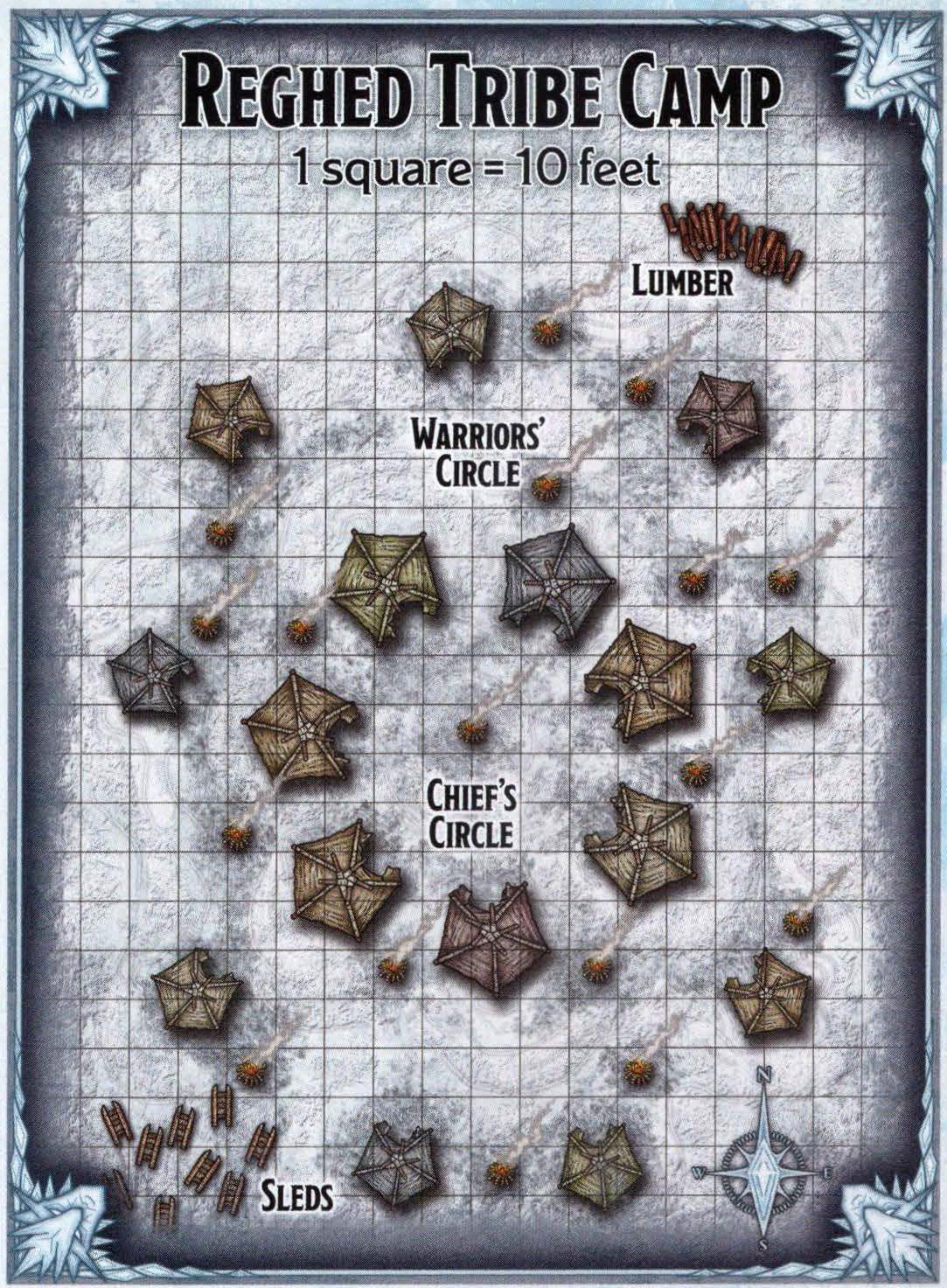 blue-eyed, wearing heavy furs and brightly dyed clothes crafted from animal hides. Their skin is bronzed from the sun and cracked by the wind. They’re a nomadic people, following the herds of reindeer along their annual migration routes and sharing their large, round tents with their sled dogs. They speak Reghedjic.
blue-eyed, wearing heavy furs and brightly dyed clothes crafted from animal hides. Their skin is bronzed from the sun and cracked by the wind. They’re a nomadic people, following the herds of reindeer along their annual migration routes and sharing their large, round tents with their sled dogs. They speak Reghedjic.
There are several core values esteemed in Reghed culture:
- The tribe is one spirit, always on the move. When the motion of the spirit comes to an end, the body dies. So it is with the tribe.
- For the tribe to survive, all must work together. And no member of the tribe is left behind by the tribe.
- The land respects only strength. The strong flourish; the weak perish.
- Magic is not to be trusted, for it is used by the weak and evil.
They are organized into a number of tribes, each of made up of a number of smaller clans unified in their devotion to a specific tribal beast totem of Tempos, the god of war. The shamans who commune with the totem spirits have great power within the tribes, but they are led by the chieftains of each clan who collectively choose the most powerful among them to become the tribe’s king or queen. (The interesting bit is defining what “strongest” means and how it will be measured.)
The Tribe of the Bear. The Tribe of the Bear often haunts the shores of the Sea of Moving Ice far to the north of Ten-Towns. The tribe has shrunk precipitously, and today there are only two clans left: One led by Wolvig Barrundson and another by Gunvald Halraggson.
The Tribe of the Elk. The largest and most populous of the tribes. Their king is Jarund Elkhardt, who views the people of Ten-Towns with a mixture of disdain (they are a “tamed people”) and disinterest.
The Tribe of the Tiger. A fractious tribe who avoids the powerful Elk while preying on the weaker Bear and Wolf tribes. They are ruled by Queen Bjornhild Solvigsdottir, who was the wife of the late King Korold and fought alongside him in many battles.
The Tribe of the Wolf. The smallest of the tribes, to survive the Tribe of the Wolf has welcomed many outsiders, including outcasts from Ten-Towns, disenfranchised members of other tribes, and even goblinoids. The Tribe is fractious and its chiefs have been unable to agree on a king for more than a decade. One of its most powerful chiefs is Isarr Kronenstrom, who worships Malar the Beast Lord and is known to hunt Ten-Towners for sport. Isarr has of late declared himself the Wolf King, despite other clan chieftains like Rhun Meirchion and Owain Lilwarch not recognizing his claims.
The Tribe of the Seal. They have actually left Icewind Dale entirely, migrating into the Sea of Moving Ice and settling in ice-fortresses as fishers and whalers. The other tribes no longer recognize them as Reghed.
The Tribe of the Caribou. Also known as the Lost Tribe, during the Spellplague the last surviving members of the Tribe of the Caribou were seen climbing atop the Reghed Glacier… and were never seen again. Some assume they died out. Other tales claim that they passed far to the north. Or the south. Or were led by the caribou totem spirits into a green paradise that lies hidden within the glacier.
Although the Tribe of the Elk has slowly learned to live in peace with the people of Ten-Towns, the other tribes are a constant threat to them. However, they spend just as much time feuding and fighting with each other. However, the tribes collectively hate orcs, white dragons, and frost giants, and will readily set aside their differences to ally against such threats.
BRYN SHANDER
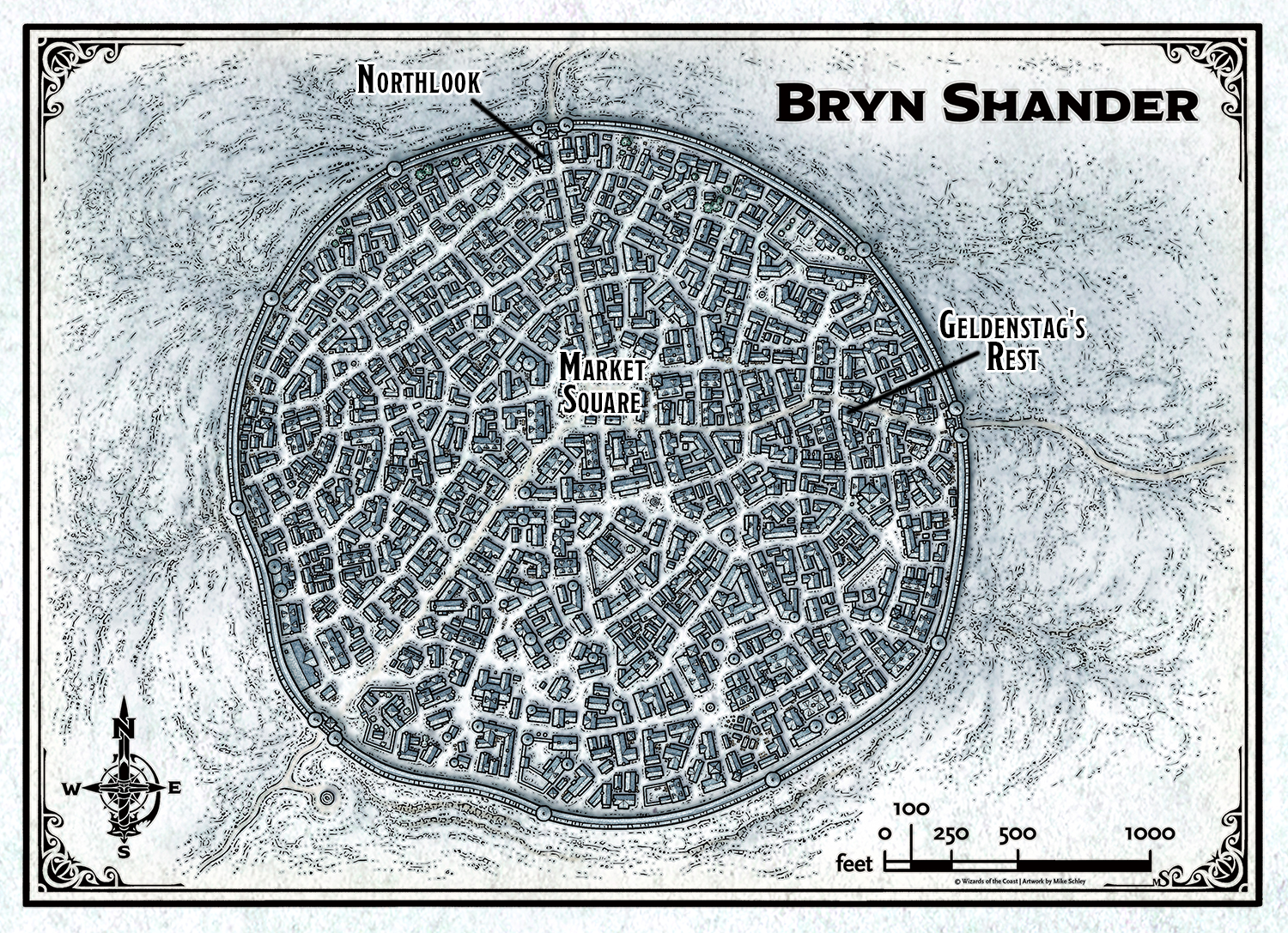
Bryn Shander is the Tenth Town of Ten-Towns. Originally it was a lone cabin on the trail to Mael Dualdon where caravanners, weary from their trip over the pass, would rest by a warm fire before continuing to their intended destination – usually Targos, the most accessible settlement in those days. Fishers from the towns often came to the hilltop cabin to meet the caravans as they arrived, eager for news from the outside world. But when scrimshanders from Termalaine began bringing their wares to the cabin to entice the richest goods from the caravans before they reached the other towns, they ignited a trade war.
As other towns sent their own traders to the cabin, new buildings and infrastructure were constructed. Finally, after a feud broke out between four of the traders that ended in bloodshed, all of the towns of Icewind Dale agreed to send speakers to the new outpost to regular business being carried out there.
Market Square: Has a number of major businesses surrounding the central market, notably including the Town Hall, Rendaril’s Emporium (where the original cabin stood and now the largest trade house in the city), Blackiron Blades (the cheapest blades in Ten-Towns!), and the Hooked Knucklehead (a cheap inn where caravan crews often stay).
The Northlook: The inn and tavern most frequented by mercenaries and adventurers, and thus the most crowded and dangerous place in town. At the same time, its taproom is the best spot in all of Ten-Towns to get leads on profitable ventures, along with the latest news and rumors. The proprietor is a retired sellsword named Scramsax.
Geldenstag’s Rest: One of the oldest establishments in town, far enough from the center of things for people to be able to keep a low profile.
TARGOS
Targos is located on the southern shore of Maer Dualdon. Nestled within a series of high cliff walls that shelter its port from the savage winter winds of the Dale, the city has also built a wall which extends out into the harbor 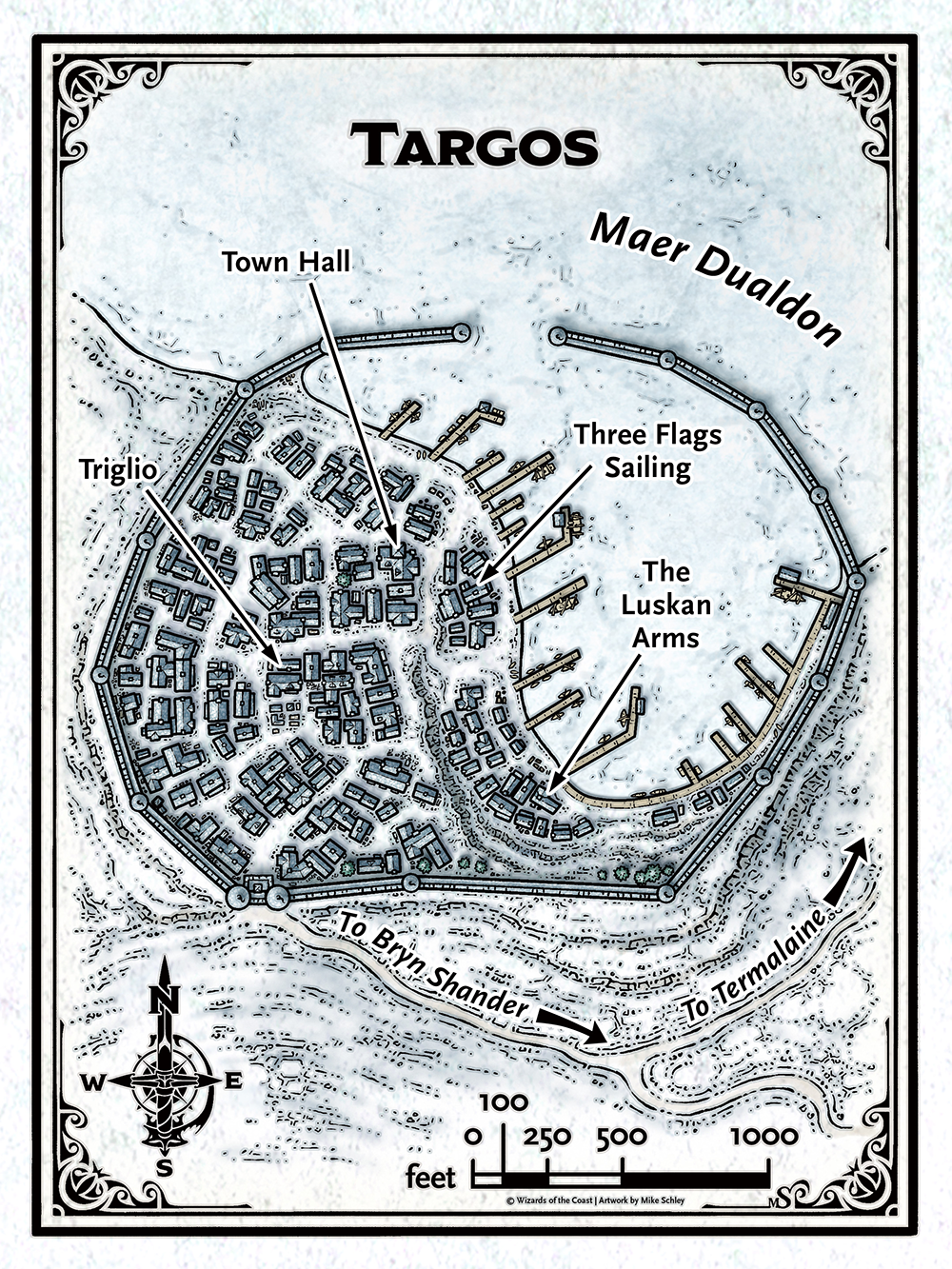 and protects their fleet from the battering storm waves that afflict the fleets of other towns. The protection of the wall also enables Targos’ shipbuilding industry to work year-round.
and protects their fleet from the battering storm waves that afflict the fleets of other towns. The protection of the wall also enables Targos’ shipbuilding industry to work year-round.
The current Speaker of Targos is Naerth Maxildnarr who was recently elected only a few months ago, displacing former Speaker Glandro Holfast (who remains the head of the Dockworkers’ Guild).
The Luskan Arms: The oldest public house in Ten-Towns, established back when Bryn Shander was still just “the camp on the hill” and Luskan was still a thriving free port. Many of the traders who came to Targos back then hailed from Luskan, so the Luskan Arms was built to look like an inn that might be found in the City of Sails. In recent years, the place has fallen into disrepair and is infested with rats.
Three Flags Sailing: A tavern frequented mostly by the local fishermen. Run by Ethel Yarbroul, a gray-haired widow better known as “Ma” by the regulars.
Triglio: A general store selling everything except fishing and sailing supplies (which are sold through specialty stores closer to the docks). It takes its name from one of the chanteys that the fishers of Targos sing while hard at work:
Trig-lee-oh, lads, an’ ‘oist upon the line!
Trig-lee-oh, lads, an’ bring yon fishers in!
Graendal’s Fine Dwarven Craft: A smithy run by Graendal Granitefist, one of the original dwarves who fled Mithral Hall with Clan Battlehammer and resettled in Icewind Dale.
Go to Hugin Jorhund Athukavore Thuunlakalaga


